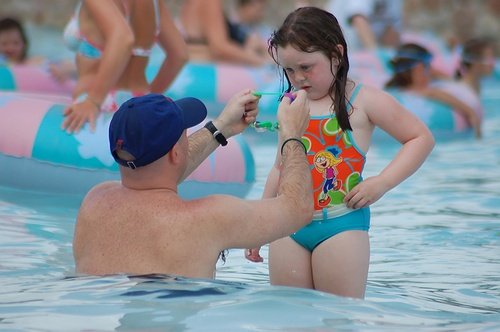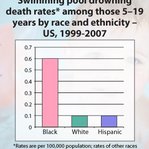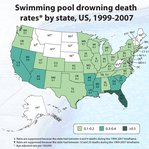Atlanta, GA - June 29, 2015 - Drowning is a leading cause of injury death for young children ages 1 to 4, and the fifth leading cause of unintentional injury death for people of all ages.1 For toddlers (children ages 1 to 4 years), swimming pools pose the greatest risk of submersion injury.2
For every child less than 15 years old who dies from drowning in a pool, another 10 receive emergency department care for nonfatal submersion injuries.3 Nonfatal drowning can cause brain damage that may result in long-term disabilities including memory problems, learning disabilities, and permanent loss of basic functions. The good news is that drowning can be prevented.
Who's at Risk?
While rates of fatal drowning in a swimming pool vary with age, gender, and race, the highest rates are among children ages 1 to 4. Males are at higher risk than females at all ages.1
Other at-risk groups include African Americans, American Indians, and Alaskan Natives.1 African Americans between the ages of 5 and 19 are six times as likely to fatally drown in pools as whites or Hispanics.1 Factors such as access to and use of swimming pools and lessons, and a combination of social and cultural issues, may contribute to the racial differences in fatal drowning rates.4 If rates could be determined by actual participation in water-related activities, disparity in minorities fatal drowning rates compared to whites would be much greater.4
The risk for drowning in a swimming pool depends on the number of pools in the area under consideration. Regionally, the rate of swimming pool drowning deaths in the United States is higher in the South and the West than in the Northeast and Midwest. Among all states, rates of swimming pool drowning deaths are highest in Florida, Arizona, Nevada, and Mississippi. Additionally, people who live in large urban areas are at higher risk of fatal drowning than those who live elsewhere.1
Reduce the Risk – Put Water Safety First
A swimming pool can be a great source of family fun and fitness. But it's important to make safety a priority to protect children and others in and around the water. Some of the most effective ways to prevent drowning include four-sided fencing, swimming lessons, life jackets, and supervision/lifeguarding. Knowing CPR can also save the life of someone who drowns. For best protection, combine several safety measures to most effectively reduce drowning risks.
Fencing
Appropriate pool fencing significantly reduces the risk of drowning.2 More than half of all swimming pool drownings among young children could be prevented by four-sided fencing that completely separates the pool from the house and the yard. The fence should be at least 4 feet high, and have self-closing and self-latching gates that open outward, with latches that are out of the reach of children.
Portable or inflatable above-ground pools have become increasingly popular, but these pools carry a significant risk of drowning, particularly in boys under the age of 5.5 Because of the flexibility of these pools, the side of the pool can collapse and cause someone to fall into the water and drown. The same safety precautions to prevent access to the water should be followed as for in-ground pools, including four-sided fencing.
Swimming Lessons
Formal swimming lessons and water-safety skills training can start at a young age. In fact, the American Academy of Pediatrics supports swimming lessons as young as age one. The decision to begin swimming lessons should be based on the individual child's exposure to water, emotional maturity, physical limitations, and health concerns.6 Participation in formal swimming lessons can reduce the risk of drowning by as much as 88% among young children aged 1 to 4 years,7 who are at greatest risk of drowning.
Life Jackets
Even in a pool, inexperienced swimmers and young children may benefit from wearing properly fitted life jackets.6 Do not use air-filled or foam toys, such as "water wings," "noodles," or inner-tubes, in place of life jackets for flotation support. These are toys and are not designed to keep swimmers safe.
Supervision
Preventing unintended pool access
Children should never be in or around a pool alone. Barriers to pool access should be used to help prevent young children from gaining access to the pool area without caregivers' awareness. Four-sided isolation fencing, door locks, gate locks, and alarms that are triggered when someone enters the water are examples of barriers. Most young children who drowned in pools were last seen in the home, had been out of sight less than five minutes, and were in the care of one or both parents at the time.8
Safety while in or around the pool
Never leave a small child alone or in the care of another child while in the pool or other water source, even if the child has had formal swimming lessons. When a young child or inexperienced swimmer is in or around water, always be within arm's length. Adults who are supervising children in the pool should not be distracted by activities such as reading, playing cards, texting or talking on the phone, or mowing the lawn. Drowning can happen very quickly and quietly.
Supervision is important even when there are lifeguards at the pool. While lifeguards enhance safety, their ability to safeguard swimmers has limitations. It's often another swimmer or bystander who first notices that someone has drowned.9
CPR
CPR performed by bystanders has been shown to improve outcomes in drowning victims.10 For example, starting CPR immediately, rather than waiting for emergency personnel, can help reduce the chance of brain damage.
References
- Centers for Disease Control and Prevention. Wide-ranging OnLine Data for Epidemiologic Research (WONDER) [online]. (2010) Available here.
- Thompson DC, Rivara F. Pool fencing for preventing drowning of children. Cochrane Database of Systematic Reviews1998, Issue 1. Art. No.: CD001047. DOI: 10.1002/14651858.CD001047.
- Gipson K. Pool or Spa Submersion: Estimated Injuries and Reported Fatalities, 2010 Report. U.S. Consumer Product Safety Commission, May 2010. Available here.
- Branche CM, Dellinger AM, Sleet DA, Gilchrist J, Olson SJ. Unintentional injuries: the burden, risks and preventive strategies to address diversity. In: Livingston IL, editor. Praeger handbook of Black American health (2nd edition): Policies and issues behind disparities in health. Westport (CT): Praeger Publishers; 2004. p. 317-27.
- Shields BJ, Pollack-Nelson C, Smith GA. Pediatric Submersion Events in Portable Above-Ground Pools in the United States, 2001 - 2009; DOI: 10.1542/peds.2010-3033 - Pediatrics; originally published online June 20, 2011.
- Weiss J. American Academy of Pediatrics Committee on Injury, Violence, and Poison Prevention. Prevention of drowning. Pediatrics 2010;126:e253–62. Available here.
- Brenner RA, Taneja GS, Haynie DL, Trumble AC, Qian C, Klinger RM, Klevanoff MA. Association between swimming lessons and drowning in childhood: A case-control study. Archives of Pediatrics & Adolescent Medicine 2009;163(3):203-10.
- Present P. Child drowning study. A report on the epidemiology of drowning in residential pools to children under age five. Washington (DC): Consumer Product Safety Commission (US); 1987.
- Pelletier AR, Gilchrist J. Fatalities in swimming pools with lifeguards: USA, 2000-2008. Injury Prevention, 2011; 17:250-253.
- Kyriacou DN, Arcinue EL, Peek C, Kraus JF. Effect of Immediate Resuscitation on Children with Submersion Injury. Pediatrics, 1994; 94 (2): 137-142.
More Information
The following resources offer information that can help you stay safe in the water:














